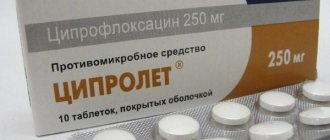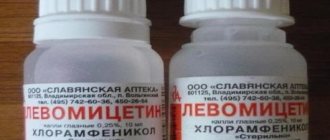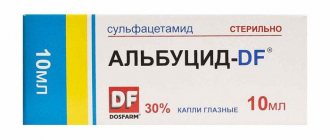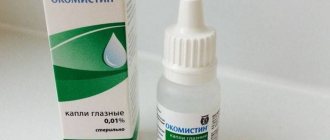Tsiprolet and Tsipromed are antibacterial drugs belonging to the pharmacological group of fluoroquinolones.
Tsiprolet and Tsipromed are antibacterial drugs belonging to the pharmacological group of fluoroquinolones.
Both drugs have a wide spectrum of action. Medications are recommended for use when eye damage occurs as a result of bacterial infection with Escherichia coli, staphylococci, Klebsiella, streptococci, spirochetes, legionella, gonococci.
Characteristics of Tsiprolet
Tsiprolet is produced in three dosage forms: in the form of eye drops, a solution for infusion and in tablet form.
The active component of the drug is ciprofloxacin. In addition to this component, the tablets contain a second active ingredient - tinidazole.
Additional components of the medication in the form of an injection solution and eye drops are the following compounds:
- water for injection;
- disodium edetate;
- hydrochloric acid;
- benzalkonium chloride in the form of a solution;
- sodium chloride.
Tsiprolet tablets contain the following compounds as additional components:
- croscarmellose sodium;
- corn starch;
- sodium carboxymethyl starch (type A);
- MCC;
- colloidal silicon dioxide;
- talc;
- magnesium stearate;
- hypromellose;
- titanium dioxide;
- macrogol 6000;
- dimethicone;
- polysorbate 80;
- sunset yellow dye (E110).
The drug in any form of release has pronounced antiprotozoal and antimicrobial properties.
The mechanism of action of the main active component is manifested in the suppression of DNA gyrase of the bacterial cell, which provokes disturbances in the process of bacterial DNA synthesis, and this leads to a slowdown in the growth and reproduction of the bacterial pathogen. This effect on the bacterial cell provokes its death.
Tsiprolet tablets are used for drug therapy of diseases and pathological conditions such as:
- Bacterial lesions of the respiratory system: cystic fibrosis, bronchitis, bronchiectasis, pneumonia and tonsillitis.
- Lesions of a bacterial nature in the ENT organs: tonsillitis, pharyngitis, otitis media, mastoiditis, sinusitis and sinusitis.
- Infection of the genitourinary system: salpingitis, cystitis, pyelonephritis, oophoritis, tubular abscess, adnexitis, prostatitis, gonorrhea, chlamydia, chancre, pelvioperitonitis and pyelitis.
- Pathologies of the digestive system: peritonitis, typhoid fever, salmonellosis, intraperitoneal abscesses, yersiniosis, campylobacteriosis, cholera, shigellosis,
- Bacterial lesions of the skin: phlegmon, abscess, burns, infected ulcers, wounds.
- Pathologies of the osteoarticular system caused by bacterial infection: sepsis, septic arthritis and osteomyelitis.
Tsiprolet is used for infections of the genitourinary system.
Tablet and injection forms of the drug can be used for prophylactic purposes to prevent bacterial infection after surgical interventions.
Tsiprolet eye drops are prescribed for drug treatment of conjunctivitis, blepharitis, and barley.
When prescribing the drug, the patient should take into account the following contraindications:
- minority;
- intolerance to the components of the drug;
- pregnancy period;
- lactation period.
The medication should be prescribed with caution when:
- impaired blood circulation in brain tissue;
- atherosclerosis of cerebral vessels;
- presence of epileptic syndrome;
- epilepsy;
- mental disorders;
- severe pathology of the liver and kidneys;
- old age.
During treatment, the patient may experience a whole range of side effects and unwanted reactions.
From the digestive system:
- vomit;
- diarrhea;
- flatulence;
- epigastric pain;
- feeling of nausea;
- bloating;
- cholestatic jaundice;
- decreased appetite;
- hepatonecrosis;
- hepatitis.
On the part of the nervous system, the patient may develop:
- insomnia;
- dizziness;
- anxiety;
- fatigue;
- tremors of the limbs;
- increased intracranial pressure;
- increased sweating;
- hallucinations;
- depression;
- confusion;
- different mental reactions;
- thrombosis of cerebral arteries;
- fainting;
- migraine.
Sense organs may react to the use of Tsiprolet with the following undesirable reactions:
- decreased hearing acuity;
- tinnitus;
- violation of taste perception;
- diplopia.
The patient may develop:
- tachycardia;
- drop in blood pressure;
- heart rhythm disturbances;
- anemia;
- granulocytopenia;
- leukocytosis.
Carrying out drug treatment with Tsiprolet can provoke the occurrence of allergic reactions in the form of urticaria, arthralgia, tenosynovitis and arthritis.
If an overdose occurs, increased side effects are observed. To eliminate the pathological condition, gastric lavage and hemodialysis are used.
The drug is dispensed at the pharmacy only after presenting a prescription from the attending physician.
Characteristics of Tsipromed
Tsipromed is produced in the form of ear and eye drops. The compositions differ in the form of the active component: in eye drops, ciprofloxacin is presented in the form of hydrochloride, and in ear drops - in the form of lactate.
Tsipromed is used to prevent inflammation after injuries or operations.
Auxiliary components of eye drops are:
- benzalkonium chloride;
- sodium edetate;
- lactic acid;
- sodium chloride;
- sodium hydroxide;
- water for injections.
Additional compounds of ear drops that play a supporting role are:
- benzalkonium chloride;
- propylene glycol;
- lactic acid.
Indications for the use of eye drops are:
- acute and subacute forms of conjunctivitis;
- keratitis;
- anterior chamber uveitis;
- blepharitis;
- dacryocystitis;
- prevention of the inflammatory process after injuries or operations.
Ear drops are prescribed for use in the following cases:
- with external otitis;
- with otitis media;
- before and after surgery;
- when receiving an ear injury;
- tissue damage when removing a foreign body.
When prescribing Tsipromed for treatment, it is necessary to take into account the possible presence of contraindications for the patient, which are:
- pregnancy;
- breastfeeding period;
- children under 1 year of age;
- intolerance to fluoroquinolones;
- hypersensitivity to one or more components included in the drug.
The drug in the form of ear drops cannot be used by patients under 16 years of age.
During therapy, the patient may experience a whole list of side effects, the most common of which are:
- allergic reaction;
- nausea;
- urge to vomit;
- bowel disorders;
- headache;
- dizziness;
- sense of anxiety.
When using eye drops, local adverse reactions may develop, manifested by:
- slight burning sensation in the first minute;
- sensation of itching or soreness;
- redness of the eye;
- swelling in the eyelid area;
- photophobia;
- increased secretion of tear fluid;
- feeling as if something was in the eye;
- white crystalline precipitate (in the presence of a corneal ulcer);
- blurred vision;
- keratitis or keratopathy.
If an overdose occurs, the patient develops:
- feeling of nausea and vomiting;
- diarrhea;
- headache;
- dizziness;
- fainting;
- sense of anxiety.
In case of overdose, it is recommended to use symptomatic treatment accompanied by drinking large amounts of fluid. The use of drugs that increase the acidity of urine and prevent the development of crystalluria may be recommended.
The sale of medicines is carried out in pharmacies only after presenting a prescription from the attending physician.
Ciprolet and Ciprofloxacin: what is the difference?
Pharmacological properties
Medicines cause the death of bacteria by interfering with the synthesis of protein and DNA molecules necessary for their reproduction, as well as disrupting the integrity of the microbial cell wall. The drugs rarely cause microbial resistance to the active substance and are active against a wide range of microorganisms:
- streptococci;
- staphylococci;
- Pseudomonas aeruginosa;
- intestinal;
- hemophilus influenzae;
- Brucella;
- legionella and many others.
Indications
- inflammation of the bronchopulmonary system;
- otitis - inflammation of any part of the ear;
- sinusitis, inflammation of the paranasal sinuses;
- infectious diseases of the urinary system;
- infectious and inflammatory diseases of the digestive system, including those complicated by peritonitis (inflammation of the peritoneum);
- inflammation of the eye and its appendages;
- sepsis (spread of a microbe throughout the body through the bloodstream);
- genital infections;
- bacterial inflammation of the musculoskeletal system;
- skin infections;
- gonorrhea, a sexually transmitted disease caused by gonococcus;
- infectious and inflammatory processes of any localization against the background of immune suppression;
- prevention of infectious complications after surgery, including in ophthalmology.
Contraindications
Are common
- individual intolerance to drugs;
- carrying a child and feeding him breast milk;
- children's age is less than 5 years for Ciprofloxacin and less than 18 years for Ciprolet.
Additional contraindications for Ciprofloxacin
- concurrent use of the muscle relaxant tizanidine;
- pseudomembranous colitis is an inflammation of the intestine caused by the bacterium Clostridium difficile.
Side effects
- allergic manifestations;
- nausea, vomiting, loss of appetite;
- diarrhea, abdominal pain;
- jaundice;
- headaches, dizziness;
- convulsions;
- anxiety, hallucinations, agitation, insomnia;
- disorder of taste and smell;
- numbness in the limbs;
- hearing and vision impairment;
- rapid heartbeat, fainting;
- feeling of heat throughout the body;
- tendon damage;
- decrease in the content of all blood cells.
Release form and price
Tsiprolet
- tablets 0.25 g, 10 pcs. 64 rubles;
- table 0.5 g, 10 pcs. RUB 117;
- 0.2% solution for infusion, 100 ml, 1 bottle 85 RUR;
- 0.3% eye drops, 5 ml 64 rubles;
- combined form (Tsiprolet A) 0.5+0.6 g, 10 pcs. 231 rub.
Ciprofloxacin
- tablets 0.25 g, 10 pcs. 22 rubles;
- table 0.5 g, 10 pcs. 43 rubles;
- 0.2% solution for infusion, 100 ml, 1 bottle 27 rubles;
- 0.3% eye drops 5 ml 22 r.;
- 0.3% eye drops, 10 ml 43 RUR;
- 0.3% eye and ear drops, 5 ml 20 rub.
Comparison of drugs Tsiprolet and Tsipromed
Both drugs contain the same active compound - ciprofloxacin. The antibiotic belongs to the group of fluoroquinolones. Both drugs have a wide spectrum of action.
Tsiprolet has more forms of release, as it is produced not only in the form of solutions, but also in the form of tablets for oral use.
The drugs differ in a set of additional components that perform auxiliary functions.
Both medicines belong to the group of prescription drugs, so a prescription from your doctor is required to purchase them.
Since the drugs use the same active compound, their indications, contraindications and side effects are largely similar to each other. This allows, if necessary, to replace one drug with another.
A broad-spectrum antimicrobial agent, a fluoroquinolone derivative, suppresses bacterial DNA gyrase (topoisomerases II and IV, responsible for the process of supercoiling of chromosomal DNA around nuclear RNA, which is necessary for reading genetic information), disrupts DNA synthesis, growth and division of bacteria; causes pronounced morphological changes (including cell wall and membranes) and rapid death of the bacterial cell. It has a bactericidal effect on gram-negative organisms during the period of rest and division (since it affects not only DNA gyrase, but also causes lysis of the cell wall); it acts on gram-positive microorganisms only during the period of division. Low toxicity for the cells of the macroorganism is explained by the absence of DNA gyrase in them. While taking ciprofloxacin, there is no parallel development of resistance to other antibiotics that do not belong to the group of DNA gyrase inhibitors, which makes it highly effective against bacteria that are resistant, for example, to aminoglycosides, penicillins, cephalosporins, tetracyclines and many other antibiotics. Gram-negative aerobic bacteria are sensitive to ciprofloxacin: enterobacteria (Escherichiacoli, Salmonellaspp., Shigellaspp., Citrobacterspp., Klebsiellaspp., Enterobacterspp., Proteusmirabilis, Proteusvulgaris, Serratiamarcescens, Hafniaalvei, Edwardsiellatarda, Providencia spp., Morganellamorganii, Vibriospp. , Yersiniaspp.), others gram-negative bacteria (Haemophilus spp., Pseudomonasaeruginosa, Moraxellacatarrhalis, Aeromonasspp., Pasteurellamultocida, Plesiomonasshigelloides, Campylobacterjejuni, Neisseriaspp.), some intracellular pathogens - Legionellapneumophila, Brucellaspp., Chlamydiatrachomatis, Listeria monocytogenes, Mycobacterium tuberculosis, My cobacteriumkansasii, Corynebacteriumdiphtheriae; gram-positive aerobic bacteria: Staphylococcus spp. (Staphylococcus aureus, Staphylococcus haemolyticus, Staphylococcus hominis, Staphylococcus saprophyticus), Streptococcus spp. (Streptococcus pyogenes, Streptococcus agalactiae). Most staphylococci resistant to methicillin are also resistant to ciprofloxacin. The sensitivity of Streptococcus pneumoniae, Enterococcus faecalis, Mycobacterium avium (located intracellularly) is moderate (high concentrations are required to suppress them). The following are resistant to the drug: Bacteroides fragilis, Pseudomonas cepacia, Pseudomonas maltophilia, Ureaplasma urealyticum, Clostridium difficile, Nocardia asteroides. Not effective against Treponema pallidum. Resistance develops extremely slowly, since, on the one hand, after the action of ciprofloxacin there are practically no persistent microorganisms left, and on the other hand, bacterial cells do not have enzymes that inactivate it.
Which is better: Tsiprolet or Tsipromed?
It is difficult to determine which drug is best to use on your own. This can only be done by the attending physician, taking into account the characteristics of the patient’s body and the course of the infectious process.
Tsipromed is best used for eye damage from dacteroides, Escherichia coli, staphylococci, Klebsiella, streptococci, spirochetes, legionella and gonococci.
Tsiprolet is recommended to be used if you have:
- keratitis;
- uveitis;
- blepharitis;
- iridocyclitis;
- dacryocystitis;
- endophthalmitis;
- conjunctivitis;
- complicated by the penetration of bacterial flora of a corneal ulcer.
The duration of use, regimen and dosage of the drug used are determined by the attending physician, depending on the severity of the pathological process and the characteristics of the physiological state of the patient’s body.








